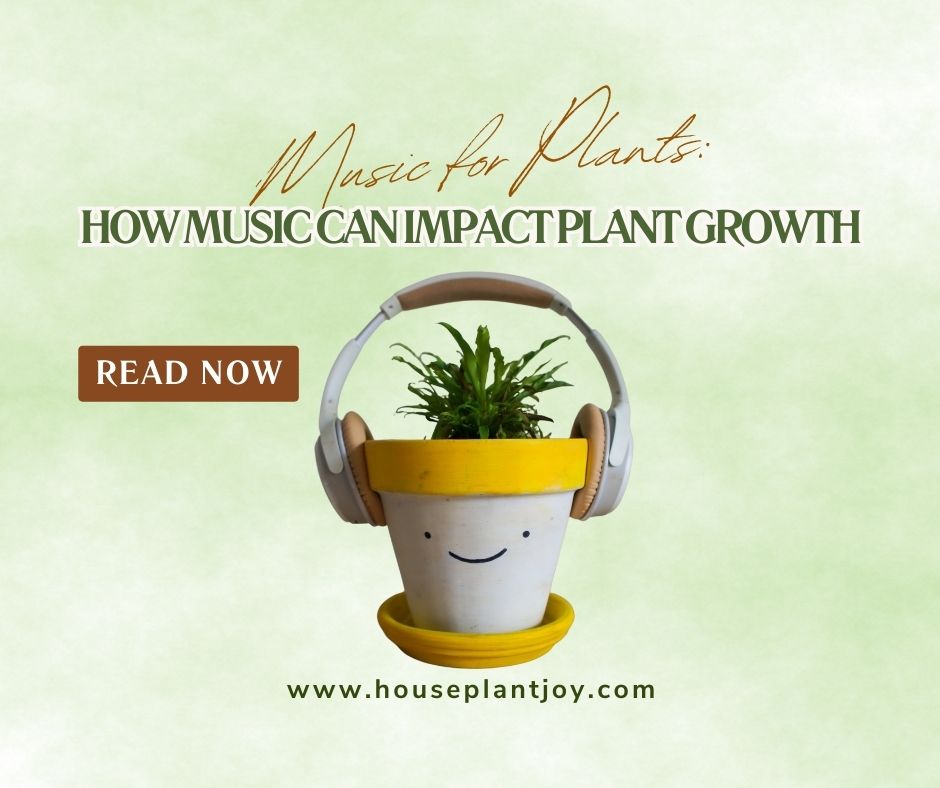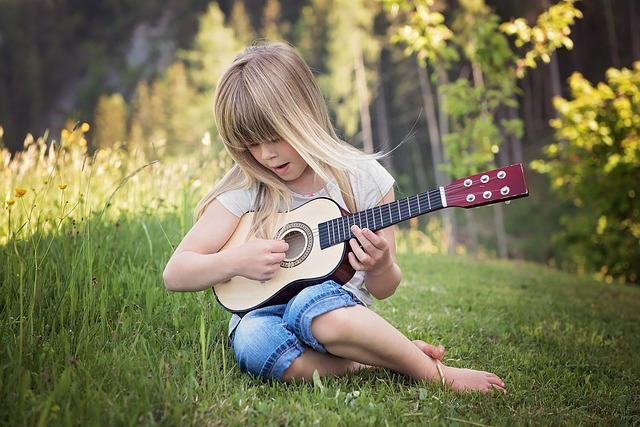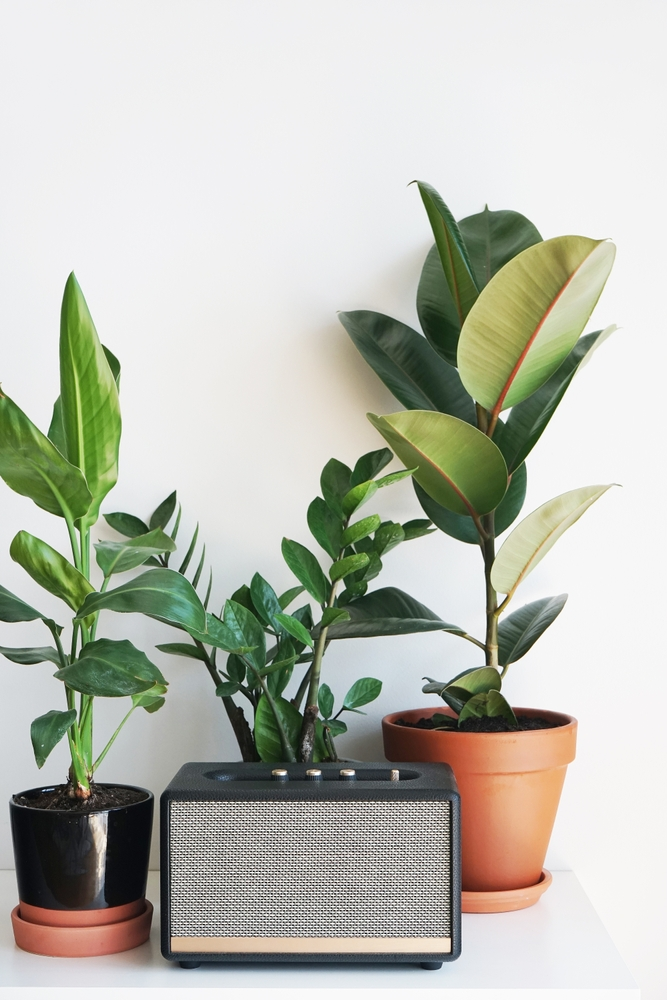HousePlantJoy is supported by our audience. When you purchase through one of our links, we may earn a small affiliate commission. As an Amazon Associate I earn from qualifying purchases. Your cost is not affected.
==================
Have you ever wondered whether your houseplants could benefit from a bit of music? The idea that playing music could impact plant growth has sparked intrigue and debate for decades. This blog post will dive into the world of music for plants. We’ll explore the science behind the concept, the ongoing debate, and how you can experiment with music for your houseplants.
Key Takeaways
- This article explores the power of music on plants and its potential to positively or negatively affect their growth.
- Studies have demonstrated that specific genres can promote plant growth, while rock/metal may be detrimental.
- Experimenting with different types of music for houseplants makes it possible to determine which type is best suited for their well-being, alongside natural soundscapes and proper care techniques.
The Power of Music on Plants
The concept of music influencing plant growth traces back to the 1970s, following the publication of “The Secret Life of Plants” by Christopher Bird and Peter Tompkins. Since then, numerous experiments and studies have been conducted to investigate the effects of playing music on plant growth. Some researchers found that classical music, in particular, positively impacts growth. Others observed the detrimental effects of rock music.
We will unfold the science behind music and plant growth, its impact on houseplants, the specific genres that may aid plant growth, and how plants grew in response to different types of music in this part.
The Science Behind Music and Plant Growth
The idea that music affects plant growth is founded on the premise that sound waves and vibrations can stimulate plant cells and nutrient movement. Studies have shown that certain types of music can positively impact growth and overall health. Dr. T.C. Singh, for example, found that exposing balsam plants to classical music increased their growth rate by 20% and biomass by 72%. This suggests that the vibrations created by sound waves could play a significant role in promoting growth.
Yet, not every music genre is equally beneficial for plants. Classical and jazz music have shown positive effects on plant growth. Rock and metal music’s intense vibrations can stress plants. Consequently, choosing the right music for your plants to promote growth-friendly vibrations is paramount.
Does Music Help Keep Houseplants Healthy?
Playing music for houseplants has been shown to have several potential benefits. These include increased growth rates and improved overall plant health. In one experiment, tomato plants in a greenhouse thrived when exposed to played music. They extend up the trellis and across the roof. This suggests that plants enjoy music. Providing a musical environment for houseplants could promote faster, healthier growth.
Yet, it’s worth mentioning that various music genres affect plant growth differently. Documented evidence shows a positive effect of Classical, Jazz, and Indian classical music. Conversely, the intense vibrations from rock and metal music might stress plants and potentially hinder growth. Hence, choosing the correct music genre is vital to enhance the potential benefits for your houseplants.
Genres That Boost HousePlant Growth and Promote Health
As mentioned earlier, specific genres of music are more beneficial for plant growth than others. Some examples include:
- Classical music, which has been repeatedly shown to promote growth in various experiments
- Jazz Music, such as ragas and Vedic music, has also been documented to facilitate lush growth in plants
However, it’s not all good news for plants regarding music. Experiments conducted by Dorothy Retallack revealed that plants exposed to rock music deteriorated quickly and perished within a few weeks. Likewise, metal music has been observed to induce stress in plants due to its intense vibrations.
Consider the genre, vibration, and volume when choosing music for your plants. This will ensure a positive effect on plant growth and health. By playing classical, jazz, or Indian classical music, you’re creating an environment that fosters their growth and overall well-being.
The Debate: Does Music Affect Plant Growth?
Despite the numerous studies and experiments suggesting a link between music and plant growth, the debate surrounding the subject remains ongoing. Some researchers have found positive effects of music on plant growth. However, others remain skeptical and doubt the validity of these experiments.
This part will present the supporting evidence alongside skepticism, illuminating the continuous discourse about the effects of music on plant growth.
Positive Effects of Music on Indoor Plants
Several documented studies show the positive effects of music on indoor plants. These include increased growth rates, improved health, and potential chemical fertilizers and herbicide alternatives. An Illinois researcher experimented to determine music’s effect on corn and soy plants. The results revealed that both plants were thicker and greener, producing a significantly higher yield. The MythBusters experiment also showed that plants exposed to death metal music grew the best, followed by those exposed to classical music.
Researchers at a Canadian university conducted a study which determined that when exposed to high-frequency vibrations. The harvest yields of crops, such as wheat, nearly doubled. This finding is significant as it suggests new methods of improving agricultural production. These findings indicate that using sound waves technology in agriculture could provide an alternative to environmental contamination and the monetary costs of chemical fertilizers and herbicides.
Skepticism and Criticism
Despite the supporting evidence, skepticism and criticism of music’s effect on plant growth persist. Some researchers doubt the validity of experiments. They suggest that other factors, such as environmental conditions or vibrations caused by the music, may be responsible for observed results. The University of California, for instance, has stated that there is no conclusive scientific evidence to suggest that playing music for plants assists in their growth.
Furthermore, some botanists have criticized the experiments claiming to demonstrate music’s effect on plant growth. They label them as pseudoscience or deficient scientifically and unreplicable. Light and water, air pressure, and soil conditions are potential variables that might not have been adequately managed or accounted for in music and plant growth experiments.
Although the debate continues, it is worth noting that playing music for plants may not be detrimental. Some scientists and farmers have reported positive effects on growth rate. Further research is needed to establish a definitive connection between music and plant growth. However, experimenting with music for houseplants can be an enjoyable and potentially beneficial pursuit.
Experimenting with Music for Your Houseplants
If you’re intrigued by playing music for your houseplants, why not try? By experimenting with different genres and types of music, you can determine what works best for your plants and potentially enhance their growth and overall well-being.
This section will guide you in experimenting with music for your houseplants, including choosing the right music and monitoring the results.
Choosing the Right Music
Selecting the right music for your plants is crucial in ensuring a positive impact on their growth and health. As discussed earlier, classical and jazz music have been observed to be particularly beneficial for plant growth. Indian classical music, such as ragas and Vedic music, has also been documented to facilitate lush growth in plants.
Consider genre, vibration, instrumentation, volume, and duration when choosing music for your plants. Some recommendations include:
- Music with stringed instruments, which has proven effective
- A moderate volume for a few hours daily
- Experimenting with high-frequency vibrations or bird songs, known to stimulate photosynthesizing plants’ growth
Remember, not all music is suitable for plant growth. Heavy metal and rock music can induce stress due to their intense vibrations. Therefore, it is essential to carefully select the type of music for your plants to ensure the vibrations are conducive to their growth.
Monitoring and Measuring Results
Once you have selected the right music for your plants, it’s essential to monitor and measure the results of your experiment. Keep an eye on key indicators of healthy plant growth, such as:
- foliage color
- absence of pests and diseases
- proper watering conditions
- healthy roots
Observing these factors lets you determine if your plants thrived during the experiment.
There are several ways to measure the growth of plants. These include the grid intersect technique, measuring plant height, and calculating the average growth rate. Let the music play for at least 30 minutes before applying foliar fertilizer and discontinue it 2 hours later. By carefully monitoring and measuring your plants’ growth, you can determine the effectiveness of your music experiment and make any necessary adjustments to optimize their growth and health.
Alternative Ways to Promote Houseplant Growth
While playing music for your houseplants can be an enjoyable and potentially beneficial experiment, it is essential to remember that other factors significantly promote healthy growth. This section explores alternative methods to enhance houseplant growth. It focuses on natural soundscapes and correct plant care techniques.
Natural Soundscapes for Plant Growth
Natural soundscapes, such as bird songs and the rustling of leaves, are advantageous for plant growth as plants respond positively to these sounds. These sounds can create a sense of connection to nature and provide a soothing environment for them to thrive. Research has demonstrated that sound stimuli can influence germination rates. It enhances growth and development and improves the yield of crops.
You can incorporate nature sounds into your indoor environment by playing recordings of natural soundscapes. These include birds chirping, rustling leaves, or flowing water. Exposing your plants to these natural sounds can create a calming environment that may promote their growth and well-being.
Proper Plant Care Techniques
Proper plant care is crucial for promoting healthy plant growth and should be the primary focus when caring for your houseplants. Critical requirements for common houseplants include:
-
-
- Maintaining a minimum temperature of 55ºF
- Avoiding cold drafts
- Watering roughly once a week
- Checking soil moisture before watering
- Providing adequate light exposure
- Keeping tropical houseplants in rooms between 65 and 75 degrees F
In addition to these basic requirements, it is essential to provide your plants with the appropriate nutrients through regular fertilization. You can ensure their growth and overall health by giving them the proper care and attention they need, regardless of whether or not you choose to play music for them. Plants help create a soothing environment when you play music around them.
-
Wrapping It Up
The relationship between music and plant growth remains a fascinating and debated topic. Some studies and experiments have suggested a positive impact of playing music on growth. Still, skepticism and criticism persist. Nevertheless, experimenting with music for your houseplants can be enjoyable and potentially beneficial. By carefully selecting the right music and monitoring the results, you can contribute to your plants’ growth and overall well-being. So, why not try it and see if your houseplants enjoy a little musical accompaniment?
FAQs
What kind of music is best for plants?
Classical music and Jazz are generally the best genres for stimulating plant growth. Plants react positively to these softer genres with stringed instruments. Studies suggest they may even take in more air if exposed to these types of music.
Do plants grow well with music?
Scientific evidence shows that playing classical or jazz music to plants can lead to increased growth. Harsher metal music can cause stress. Plants seem to be sensitive to sound and respond well to gentler audio cues. This makes music a potentially beneficial factor in their growth. However, keep in mind that some music, including metal and rock music, stress them in a negative way.
What sound is healing for plants?
When choosing music for plants, carefully consider the genre. Classical Indian music and 432 Hz frequency have both been found to be beneficial for plants. They provide relaxation and promote their growth. Plants exposed to classical music show the most potential. In fact, such inspiring music affects growth in many studies.
How often should I play music for my houseplants?
Play music for your houseplants several hours a day until around 10 a.m. This will help them close their stomata during the heat of midday. However, if your days are cooler, you might continue playing throughout the day.
Are there any genres of music that should be avoided when playing music for plants?
While research indicates that playing music for plants seems to affect growth, heavy metal, and rock music positively should be avoided. Consider that when playing music for plants. Their intense vibrations can induce stress in them. Like every living thing, they respond to positives and negatives according to the noise and vibrations. The sounds of bird songs and wind might also be useful to encourage healthy plants. See if they respond positively and with similar results.
Learn More About Houseplants!
Discover more facts and tips about your houseplants ! Join us on Facebook, Instagram, and Twitter for beautiful photos, plant care tips, and a community that celebrates the joy of indoor gardening.
Facebook: https://www.facebook.com/houseplantjoyblog
Instagram: http://instagram.com/houseplantjoy20
Twitter: https://twitter.com/HouseplantJoy
Let’s nurture our green spaces together!








